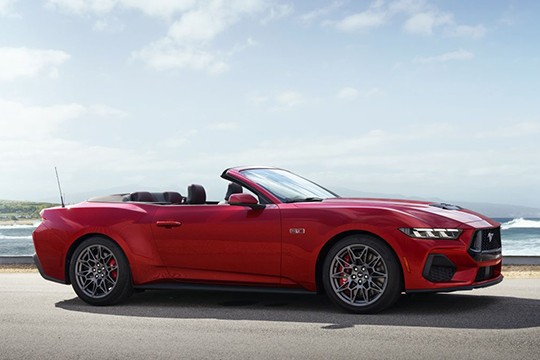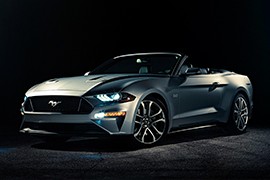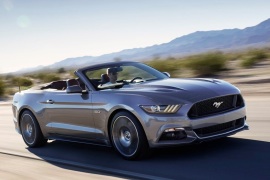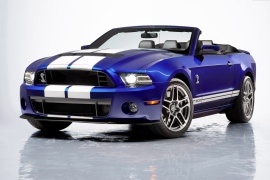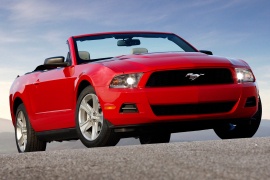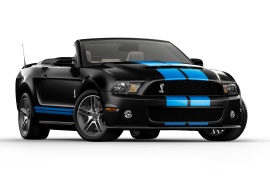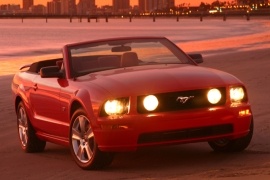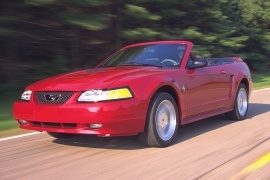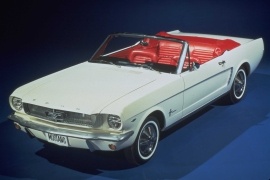FORD Mustang Convertible Models/Series Timeline, Specifications & Photos
First production year: 1964
Engines: Gasoline
Body style: Convertible (spider/spyder, cabrio/cabriolet, drop/open/soft top)
Ever since the Mustang's first generation, Ford offered a drop-top version for this model, and in late 2022 it also brought the GT Convertible.
The Mustang convertible was part of the pony car culture, and these open-top versions attracted thousands of customers ever since the 1964 ½ model year appeared on the market. Considering this, it was obvious that Ford wouldn't launch any new generation without a rag-top version. Thus, in 2022, along with the introduction of the Mustang's seventh sequel, it also created such a model. In addition, it also made it with a GT package.
As expected, the front of the car retained the same design language shared with its GT coupe sibling, including the hood with the vents on it. Moreover, the front fascia retained the hexagonal-pattern mesh design for the upper and lower grilles and the side scoops. From its profile, the GT convertible revealed its thick A-pillars that also served as a safety arch.
The cabin showed a completely different design than the sixth generation of the Mustang. For starters, the double-bubble dashboard design was replaced by a more conventional one. On the plus side, the analog instrument cluster was replaced by a 12.4" wide TFT in front of the driver, continued by a 13.2" touch-screen placed atop the center stack. All four seats featured bolstered areas. In the back, like in any other Mustang convertible, there was very limited legroom. Fortunately, thanks to the retractable roof concealed behind the cabin, the headroom was enough.
For the powertrain, Ford chose the 5.0-liter Coyote engine as the sole option for the GT Convertible, which paired it with either a six-speed manual or a ten-speed automatic.
A real eye-catcher, the 2017 Ford Mustang was a luxurious, fast muscle car, available as a coupe or a convertible body style.
With a choice of powerful engines and lots of interior upgrades, accompanied by a sharp handling, the Ford Mustang was one of the top choices for convertible lovers.
Besides the looks and power, safety was one of the Mustang’s strongest points. It managed to earn 5 stars out of five for overall crash protection, front-impact protection and side-impact protection.
Inside, high-quality materials were used throughout the cabin, however, Mustang remained truthful to its retro design with the dual-cowl dashboard. Ford made sure to add the modern technologies found in European luxury vehicles and some of the features included were standard keyless entry and keyless go, a rear-view camera, Track Apps and Sync Voice command system.
The standard seats were comfortable and provided plenty of bolstering, however, customers could have chosen the Recaro seats that increased lateral support.
Space wise, the Mustang did not have the roomiest cabin, and it was best to avoid having adults in the rear seats. The cargo area was surpassingly generous for a sports car, at least with the top up.
The 2017 model was available in five trim levels: V6, EcoBoost, EcoBoost Premium, GT and GT Premium.
Those looking for the fastest ride the Mustang could offer had the choice of a 5.0-liter V8 engine that developed 435 hp.
The Mustang is one of the best-known vehicles from the blue-oval brand. In 2014, the sixth generation of the original pony-car was launched and it was the first Mustang to be sold worldwide.
The history of the Mustang goes back to '60s when John Oros, a designer who's parents emigrated from Transilvania (Romania) draw the concept and won the internal design challenge with his team. In 1964 the first final model rolled out the factory and started its life as the 1964 ½ model. The rest was history.
Mr. Oros passed away in 2012, but his design concept lived on in the 2014 model, with the retro-design look of the vehicle. The initial idea was to draw "a car that the ladies would love that the men would love just as much". The long hood, sloped cabin, and aggressive look were the strong points in the car's design.
Unlike the original Mustang, which was based on a chassis from the Ford Fairlane, 2014 had its own platform, but for the convertible, it still needed a chassis. That made the car heavier than the coupe, but somehow more appealing by its look.
The interior had the classic look with modern necessities. Due to the rear storage space needed for the canvas-top, the rear seats were moved forward and thus cutting the legroom needed for adult passengers. Ford installed all of its new features for the Mustang Convertible, including its SYNC3 infotainment system.
At the time of the launch, there were three engines available: a 2.3-liter four-pot, a 3.7-liter V6, and a 5.0-V8 engine.
FORD Mustang Convertible 2.3L EcoBoost 6AT RWD (314 HP)
FORD Mustang Convertible 2.3L EcoBoost 6AT RWD (317 HP)
FORD Mustang Convertible 2.3L EcoBoost 6MT (317 HP)
FORD Mustang Convertible 2.3L EcoBoost 6MT RWD (314 HP)
FORD Mustang Convertible 3.7L Ti-VCT V6 6AT RWD (300 HP)
FORD Mustang Convertible 3.7L Ti-VCT V6 6MT RWD (300 HP)
FORD Mustang Convertible 5.0L Ti-VCT V8 6AT (435 HP)
FORD Mustang Convertible 5.0L Ti-VCT V8 6AT RWD (421 HP)
The Shelby Mustang was for Ford something even more important than the AMG for the Mercedes-Benz. It was the name that helped Ford to win the LeMans race. And it was an important badge ever since.
After two decades since the launch of the original SVT Mustang Cobra, the American car-maker launched a new, mean, convertible machine. It was built to blast around on the racetrack in week-end races and cruise around nice and proud as well. On top of that, the silver Cobra logo on its grille told the bystanders that it wasn't a regular Mustang.
The Mustang Cobra was a car to be respected on the road. Its mean look, with a dome hood and massive dual grille split in half by the front bumper, had a unique appearance on the road. It was the kind of car that could drive around nicely, or scream from the top of its supercharged engine. The flared front fenders and muscular look of the rear quarter-panels told the same story of an angry car that could run faster than it looks.
Inside, the Mustang Shelby was not the basic, V6 Mustang with cloth seats. It featured standard Recaro seats and, between the big round dials in the instrument cluster, there was a TFT display for the on-board computer. The seats in the back were usable.
Under the hood, the V8 was aided by a Roots supercharger and t was mated to a 6-speed manual transmission. The revised suspension and the big Brembo brakes helped the car run faster on a race-track. It was 3.5 seconds faster on the 3.74 miles (6.02 km) Sebring International Raceway track.
After 45 years on the market, the Mustang was still the king of the pony-cars and managed to attract many buyers into Ford's showrooms around the world.
Ever since its first generation, the Mustang was available with a rag-top option. While its coupe or fastback version was meant for performance and speed, the open-top version was about styling. Ford offered the Mustang with a folding fabric roof, and its customers appreciated it more than the practical metallic roof.
Ford introduced the fifth Mustang generation in 2005 and, after four years, it brought a facelifted version. It was a good time since the economy started to get back on its feet after the world economic crisis. The convertible version received a more aggressive grille, enhanced with the first new Mustang emblem since the car's introduction in 1964. Both the V6 and the GT had new sculptured front-end designs, unique for each model. The headlights featured integrated lamps and turn-signals into one unit. The V6 version featured fog lamps on the lower bumper area, while the GT had them installed in the upper grille, similar to those from the 1967-1968 model. The Mustang showed new LED taillights in the back, which resembled the original design with three vertical lamps.
Like its non-facelifted version, the Mustang cabriolet kept the roof behind the rear seats, which were pushed forward to accommodate the canvas-roof assembly behind them. The owner could have covered it with a tonneau and make the car looks sleeker while still keeping the car's retro-design classic look.
Under the hood, Ford offered more power for the V-6 and the GT versions. Both engines were paired as standard to a five-speed manual, while a five-speed automatic was on the options list.
When Ford and Caroll Shelby joined their forces to built the GT500, the blue-oval carmaker decided to offer the car as a coupe and a convertible as well.
In 2004, Ford successfully introduced the fifth generation of the Mustang. After forty years, the original pony-car was famous once again. This time, the design was right, and its retro-styling was the key to get to the customer's wallets. While the car was available with less-powered versions, in the beginning, the GT500 was a promise for thrills and surprises, which were brought either as a fastback coupe or a convertible.
The GT500 featured a more aggressive look with the silver snake badge on the black front grille. To make room for the supercharged V8 engine, the car featured a wide dome on the hood with three extracting vents on it, needed for cooling. A special aerodynamic package with a lower lip spoiler, side sills, and a duck-tail on the trunk lid completed the image. Unlike the rest of the range, the GT500 Convertible featured fog-lights installed on the lower bumper area, not in the grille.
To keep its occupants fixed, Ford Mustang Shelby GT500 featured a pair of bucket seats for the front passengers. The dashboard featured a new infotainment unit on the center stack. Ford's designers followed the aftermarket community ideas and offered additional gauges on the A-pillars in the options list.
Ford Mustang GT500 featured a supercharged V8 engine paired to a heavy-duty 6-speed manual gearbox. SVT engineers retuned and upgraded key chassis components, which made the car corner faster. They also stiffened the suspension, revised spring rates, and improved the five-link rear solid axle.
The 2004 Mustang was a true revival of the original model, launched four decades before it. Ford unveiled it in late 2004 as a 2005 model-year.
Despite being produced less than the Model-T or the F-Series, the Mustang was one of the best known Ford of all times. After some shady generations, especially the second and third (Fox-body), the fifth generation took its inspiration from the original model and started the retro-design trend.
Like the original Mustang, the 2005 model featured two round headlights at the front. The GT version's grille was enhanced with another pair of round headlamps, as the 1965 Mustang GT. The carmaker dropped the three-box body and adopted only the fastback and the convertible. The latter featured a power-retractable soft-top. In the back, the taillights resembled the original Mustang, with the three vertical lamps.
Inside, the carmaker installed two bucket-seats at the front and a bench in the rear. Since the soft-top was stored between the rear seats and the trunk, there was limited room for passengers on the bench. Ford didn't go all the way with the retro-design theme and installed a different instrument cluster, with two big round dials and four smaller gauges between them.
Ford offered the Mustang with two engine choices: a 4.0-liter V6 and a 4.6-liter V8. Both versions were paired to a 5-speed manual, while a 5-speed auto was on the options list. Ford faced some criticism for installing a live rear axle to the 2005 vehicle, a solution that handled worse than an independent suspension.
Ford introduced the facelifted fourth generation of the Mustang Cabriolet in December 1998, just in time for those who had to get all the money to buy it for the next open-top season.
The facelifted version showed such a radical change that some considered it as a new generation. But Ford stated that it was just a facelift, a major one.
The Mustang SN-99 (fourth-generation facelift) abandoned the bio-design lines and embraced the new-edge-design styling for starters. Its sharp-looking headlights with precise cuts and angular-looking grille were a big departure from its predecessor's rounded lines. A pair of fake air intakes in front of the rear wheel-arches mimicked a pair of cooling ducts for the rear brakes on the sides. In the rear, the taillights sported a similar shape as the original 1964 Mustang, with vertical lamps. Like on its predecessor, the canvas roof was completely retractable behind the rear seats.
Inside, the rounded lines were still there, with a wave-like dashboard that resembled the original design of the 1964 ? Mustang panel but with a deep center stack extended to the center console. The front bucket seats were built for comfort, but the carmaker offered a pair with higher bolstering as an option. In the back, there was slightly room for two adults, but enough for short trips.
Ford installed the 3.8-liter V6 engine for the base model mated to a 5-speed manual gearbox under the hood. Its power was increased by 45 hp when compared to its predecessor and reached 190 hp. For the 4.6-liter V8, Ford raised the power from 215 hp to 260 hp. A four-speed automatic transmission was on the options list.
The first generation of the Mustang gained a worldwide cult-car status, and the convertible version became a hit just as much as the fastback version.
The original pony-car and the wild horse badge on its grille helped the car be recognized at a glance. Ford designed the Mustang for the younger generation. It was available either as a three-box sedan coupe grocery-getter with a six-cylinder under the hood or with a big V8 engine that could tear-up the tarmac and impress your friends. Regardless of the engine choice, the Mustang was a highly customizable vehicle.
The top-down version featured a power-roof that required some manual work to place a vinyl cover over the retracted canvas behind the rear seats. It was an era where a car had to show some drama to be taken into consideration by the market, and the Mustang convertible had it all: the easy to recognize front fascia, the open-top, and the specific taillights in the back with three vertical light strips. On its sides, a subtle combination of lines converged toward the rear quarter panels.
There were two bucket seats in the front with a floor-mounted gearshift and a backbench. In front of the driver, the complete dash-panel with its four round dials and a wide speedometer completed the image of that special car.
Ford offered the Mustang convertible with a wide choice of engines, starting with a low-powered inline-six that offered just 100 hp while the other option was a 4.3-liter V8 good for 164 hp. In the second half of 1964, Ford replaced these engines with a 3.3-liter and a 4.7-liter that offered 120hp and 210 hp, respectively.
